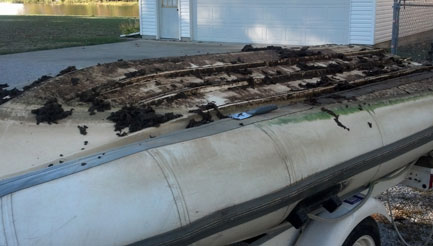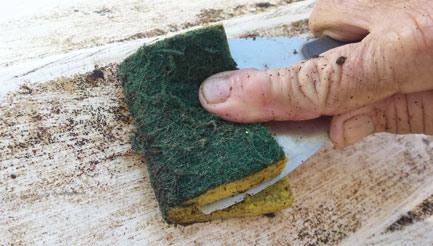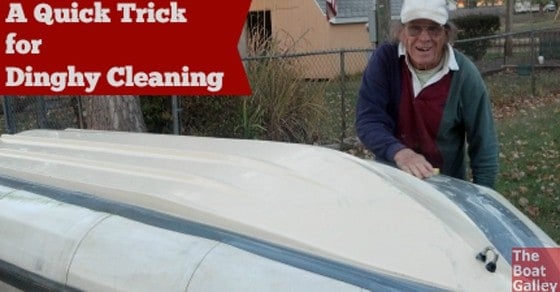Yesterday, we discovered a much more efficient technique for scrubbing the bottom of the dinghy. Now, I know that someone’s going to say they’ve been doing this for years (why didn’t you tell me??!), but here it is for everyone else.
We live on a small lake in the summer and instead of a pontoon, ski or bass boat like everyone else on the lake has, we have a dinghy. An 11-foot Avon RIB. It stays in the water all summer, and while there aren’t barnacles as there’d be in salt water, it does pick up a lot of soft growth in 5 months.

Before it goes in the water every spring, Dave puts a coat of Star-Brite Marine Polish with PTEF on it — this really makes the cleaning easier (note: the link is to the wax on Amazon — Amazon’s picture is wrong, the 14-ounce is the paste; the 16 and 32-ounce sizes are a liquid, which is what we use as it’s much easier to apply). This wax isn’t the secret — I think a lot of people use wax on the dinghy — but since it’s also a help I thought I’d tell about it for anyone who doesn’t wax theirs.
The first step in cleaning — after we take the motor off and flip the dinghy over — is scraping off as much of the black gunk as we can with 2-1/2″ putty knives. In salt water, we’re scraping barnacles off too. Then we get out the green scrubby sponges and the real work begins as we scrub all that black crud off. My hands ache at the end of it from pressing so hard to scrub.
This year, though, I had a revelation. What if I used the putty knife to give some stiffness to the scrubby sponge? Sort of like using a block of wood and wrapping a piece of sandpaper around it?

Why, oh why didn’t we think of this eleven years ago? It took half the effort to scrub and less than half the time to get the dink all spotless again. Cleaning the dinghy still isn’t my favorite job, but I don’t hate it nearly so much now. And it’s much faster when it’s clean!
I bet this will make any cleaning with the scrubbies a LOT easier . . .

Carolyn Shearlock has lived aboard full-time for 17 years, splitting her time between a Tayana 37 monohull and a Gemini 105 catamaran. She’s cruised over 14,000 miles, from Pacific Mexico and Central America to Florida and the Bahamas, gaining firsthand experience with the joys and challenges of life on the water.
Through The Boat Galley, Carolyn has helped thousands of people explore, prepare for, and enjoy life afloat. She shares her expertise as an instructor at Cruisers University, in leading boating publications, and through her bestselling book, The Boat Galley Cookbook. She is passionate about helping others embark on their liveaboard journey—making life on the water simpler, safer, and more enjoyable.
Your VHF can do so much! Learn how to use ALL its features for just $39:











Skylar Walker says
Good idea for cleaning our kayak as well! Thanks
Lynn Duggan says
Great idea! Love the wax idea for slippery surface. I do use the sponge and putty knife but I find that spraying the surface with Krud kutter, waiting a bit to let it work and then scrubbing the surface cuts the time in half again….
Carolyn Shearlock says
Oooh, will try the Krud Kutter too (it’s non toxic so shouldn’t be a problem to use around the water). Maybe it’ll cut the time in half again?!
Waterwoman says
Another thought for a “scrubby” would be the happy smiling Yellow “Scrub Daddy”. When cold, they are hard enough to scrub scum, when warm they will clean something more delicate. I am sure they can be bought at Amazon, I buy mine from QVC.
Thanks for the info Carolyn!
Lupari Sue says
Good idea. Will try that next time.
Nicola Kamper says
We use the scraper and then 3M 07447 pads. (I ordered a whole box on Amazon) They work really well on the dink bottom and also for scrubbing the bbq and dishes that were used in the bbq. We use these almost every day for one scrubbing chore or another…it seems we never run out of things to scrub & clean! 🙂
Carolyn Shearlock says
We’ve used similar ones in the past and I’m sure that folding one over the putty knife/scraper would make it even more effective and less tiring on my hands.
Bruce says
I often use a heavy plastic container bottom for removing soft growth; oil often comes in suitable containers – the gallon size for a big one and quart size for smaller. I just trim the bottle about two inches above the bottom as straight and level as possible. This makes it easier to hold and the sharp flat plastic has enough give to not scratch the paint but is strong enough to remove soft material. The top gets repurposed as a funnel or scoop. Free, no need to order them.
Jennifer Swart says
pressure wash- WAY easier
Deborah Ruths-Brown says
I wish I had a dinghy to clean….one day!
Sherry McCampbell says
Thanks for sharing!
Carolyn Shearlock says
Jennifer Swart – we’ve tried pressure washing in the past and there was still a lot to do by hand. And can’t pressure wash on a beach anywhere 🙂
Heather Reimer says
Our trick, just recently learned, was to use sand. Duh!!! The locals here in Ecuador saw us struggling with scrubbies, and proceeded to shove us aside and do it for us. Free and available anywhere. Lesson learned.
Deb Akey says
Carolyn Shearlock what about using something like this? http://amzn.to/1Q5kliJ
Jonathan says
Put bottom paint on your RIB, including the pontoons up to the waterline. Never scrub again.
Glen Vienna says
After you scrub the heavy stuff off, spray some Lime be Gone, purchased at Smart and Final. Get a spray bottle and spray it on, then wait a couple of minutes and a lot of the scum and scale will just disappear.
Les says
Why not just pull the dink out of the water when you are not using it? Bingo no scrubbing at all!
Les
Carolyn Shearlock says
Even with pulling it out every night and on passage, with full time living aboard and use we find we have to clean it at least a couple of times a year.